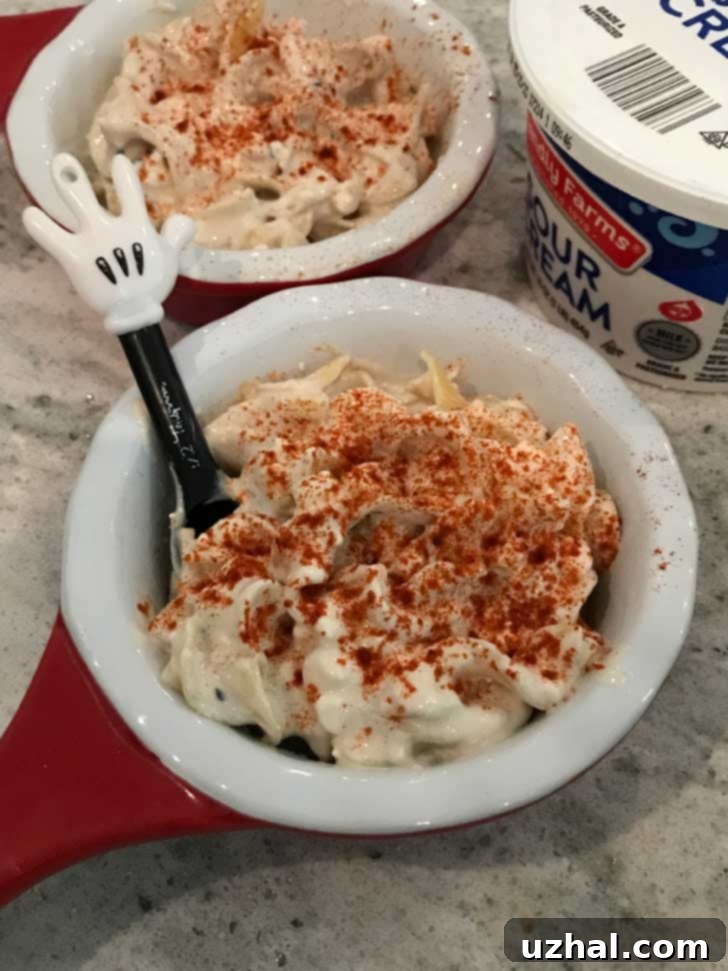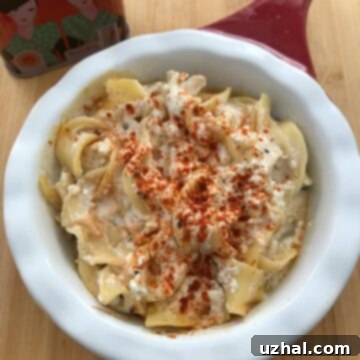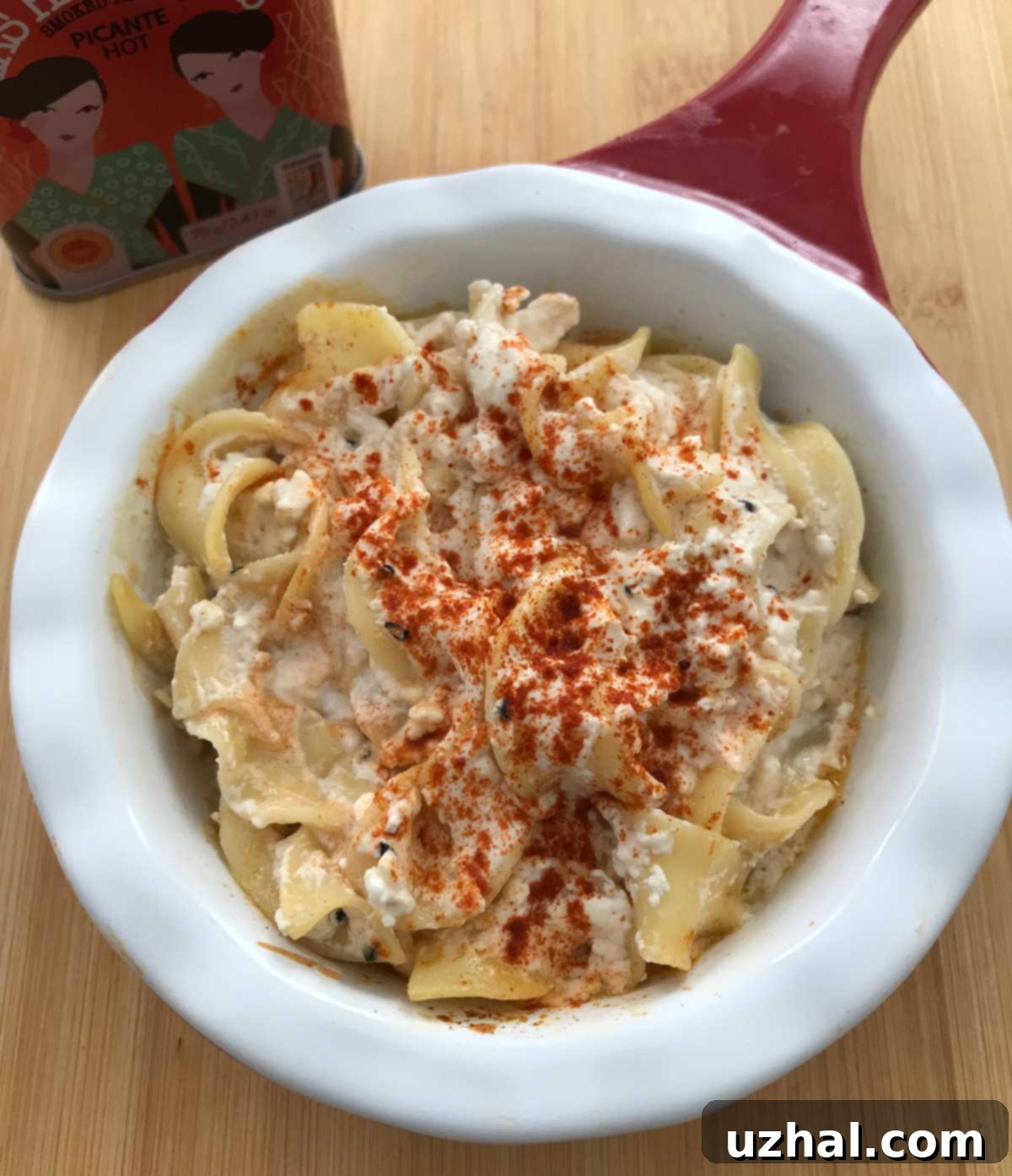Classic Hungarian Noodle Casserole Recipe: A Comforting Family Favorite
For years, this particular recipe has held a special place in my culinary repertoire, eliciting delightful emails from readers who kindly share how it has become a cherished family favorite in their homes. While I’m always happy to accept praise, the true credit for this incredibly flavorful and versatile Hungarian Noodle Casserole belongs to the Junior League of Palo Alto. Their original creation inspired this adapted version, a dish that consistently delivers on taste, comfort, and adaptability. Whether you envision it as a rich, satisfying side dish or a hearty main course, this baked noodle casserole promises to be a delightful addition to your table.

The Junior League’s version of this Hungarian Noodle Casserole was initially designed to serve a large gathering, often prepared in two 9×13 inch pans. For practical purposes in a typical home kitchen, I’ve scaled down the quantities to a more manageable size, which is reflected in the detailed recipe card below. However, the beauty of this dish lies in its scalability; it can easily be doubled for larger families, potlucks, or holiday feasts. Beyond adjusting the serving size, I’ve also gathered a collection of notes and personal modifications that I’ve discovered over countless batches. These insights will help you customize this comforting dish to perfectly suit your taste and dietary preferences.
Why This Hungarian Noodle Casserole Will Become Your Go-To
This baked noodle casserole isn’t just another dish; it’s an experience. Its unique blend of creamy, savory, and subtly spiced flavors creates an incredibly satisfying meal that appeals to nearly everyone. The magic happens with the harmonious combination of tender egg noodles, rich cottage cheese, and tangy sour cream, all elevated by aromatic seasonings and a touch of paprika. It’s the kind of comfort food that warms you from the inside out, perfect for chilly evenings or busy weeknights when you need something reliable and delicious. Plus, its versatility makes meal planning a breeze – easily adapting from a simple side to a full-fledged main course with minimal effort.
Essential Ingredients for a Perfect Hungarian Noodle Casserole
Every great recipe begins with quality ingredients, and this Hungarian Noodle Casserole is no exception. Here’s a closer look at what you’ll need to create this culinary delight:
- Broad or Fine Egg Noodles: These are the backbone of our casserole. Choose good quality egg noodles and cook them al dente according to package directions. Overcooked noodles can become mushy, losing their delightful texture in the casserole. Remember to generously salt your cooking water for optimal flavor absorption!
- Chopped Onions: Half a cup of finely chopped onions provides a sweet, aromatic base that infuses the entire dish with depth.
- Finely Chopped Garlic: Two cloves of fresh garlic, minced, add a pungent and savory kick. The aroma of sautéed onions and garlic is truly the start of something delicious.
- Low-Fat or Full-Fat Cottage Cheese: This ingredient might surprise some, but cottage cheese is crucial for the casserole’s signature creamy texture and a mild, tangy flavor. Both low-fat and full-fat varieties work well, with full-fat offering a richer end product.
- Sour Cream: Two cups of sour cream contribute to the dish’s luscious creaminess and characteristic tang. Opt for full-fat sour cream for the best flavor and texture, though a quality low-fat option can be used to lighten the dish slightly.
- Worcestershire Sauce: A secret weapon for umami! Two tablespoons of Worcestershire sauce add a layer of complex, savory depth that you won’t want to skip.
- Salt & Ground Pepper: Basic seasonings are essential to balance and enhance the flavors of the dairy and aromatics. Adjust to your personal taste.
- Hot Pepper Sauce (e.g., Tabasco): A couple of dashes provide a subtle warmth and a gentle kick that beautifully cuts through the richness. Feel free to use more or less depending on your preference for spice.
- Poppy Seeds OR Nigella Seeds: These tiny seeds are an authentic Hungarian touch, adding both flavor and texture. Poppy seeds offer a mild, nutty crunch. However, I personally prefer Nigella seeds (also known as black cumin or kalonji) for their more distinct, slightly oniony, and pungent flavor that elevates the casserole.
- Paprika for Dusting: Beyond its vibrant color, paprika is indispensable for its flavor. Depending on your choice (sweet, hot, or smoked Hungarian paprika), it adds an earthy, sweet, or spicy note to the finished dish.
- Shredded Parmesan Cheese (Optional): For those who enjoy an extra layer of salty, cheesy goodness, a sprinkle of Parmesan before serving or during the last few minutes of baking can create a delightful crust.
Easy Step-by-Step Instructions to Master This Casserole
Making this comforting Hungarian noodle casserole is simpler than you might think. Follow these straightforward steps to achieve a perfect, golden-brown bake every time:
- Prepare the Noodles: In a large pot of generously salted boiling water, cook the egg noodles until they are al dente. This means they should be firm to the bite, as they will continue to cook in the oven. Drain them thoroughly and set aside.
- Preheat Oven & Dish: Preheat your oven to 350 degrees F (175 degrees C). Take a 13×9 inch glass casserole dish and lightly rub it with butter or spray it with cooking spray. If you’re halving the recipe for a smaller serving, an 8-inch square dish will be ideal.
- Craft the Creamy Mixture: In a spacious mixing bowl, combine the chopped onions, finely minced garlic, cottage cheese, sour cream, Worcestershire sauce, salt, ground pepper, and hot pepper sauce. Stir these ingredients vigorously until they are well blended and form a smooth, creamy base.
- Combine Noodles and Flavors: Add the cooked and drained noodles to the creamy mixture in the bowl. Toss gently but thoroughly to ensure every noodle strand is evenly coated with the sauce. Once coated, stir in the poppy seeds or Nigella seeds, distributing them throughout the noodle mixture for pops of flavor and texture.
- Bake Until Golden: Pour the entire noodle mixture into your prepared casserole dish, spreading it out evenly. Cover the dish loosely with aluminum foil to prevent the top from browning too quickly. Bake in the preheated oven for approximately 30 minutes, or until the casserole is heated through, bubbling around the edges, and the noodles are tender.
- Finish and Serve: Carefully remove the foil. Before serving, sprinkle the top generously with paprika. If you’ve chosen to add Parmesan cheese, sprinkle it on now and, if desired, return the casserole to the oven for another 5-10 minutes (uncovered) to melt and lightly brown the cheese, creating a delicious crust. Serve hot and enjoy!
Customizing Your Casserole: Personal Touches and Variations
One of the many reasons this Hungarian Noodle Casserole remains a favorite is its incredible flexibility. While delicious in its classic form, don’t hesitate to experiment with these variations:
- Onion and Garlic Adaptations:
- Omit Onions: If onions aren’t to your liking, or if you simply don’t have them, the casserole will still be delightful. The other robust flavors ensure it doesn’t fall flat.
- Garlic Sensitivity: For those sensitive to fresh garlic, or to avoid high FODMAPs, a clever trick is to use garlic-flavored oil. Toss the cooked noodles in a little garlic oil instead of adding fresh minced garlic to the sauce. This imparts garlic flavor without the potential digestive discomfort.
- Dairy Variations:
- Lightening the Dish: Low-fat cottage cheese performs admirably in this recipe, especially when balanced with regular (full-fat) sour cream. This allows you to reduce some fat without sacrificing the creamy texture. I’ve successfully used 1% cottage cheese. While I haven’t tried a completely low-fat version (both cottage cheese and sour cream), a slight reduction is certainly achievable.
- Ricotta Swap: For a slightly different, perhaps even creamier and subtly sweeter profile, consider swapping some or all of the cottage cheese for ricotta cheese.
- Playing with Paprika and Heat:
- Paprika Exploration: This casserole is a fantastic canvas for exploring different types of paprika. Beyond sweet Hungarian paprika, try hot paprika for a noticeable kick, or smoked paprika for an added layer of complexity. My family often experiments with various brands and heat levels; for instance, while Tres Hermanas offers a mild warmth, a truly spicy Hungarian paprika is my husband’s preference for an extra kick.
- Beyond Tabasco: If you enjoy more heat, a pinch of cayenne pepper, a dash of sriracha, or even a different type of hot sauce can introduce new flavor dimensions.
- Seed Sensations:
- Nigella Seed Preference: While poppy seeds are traditional, I strongly advocate for Nigella seeds (black cumin). Their distinctive, slightly peppery, and oniony flavor is incredibly aromatic and adds a unique depth that I find superior to poppy seeds. If you haven’t tried them, this dish is a perfect introduction!
- Baking and Serving Flexibility:
- Individual Servings: For elegant presentations or portion control, divide the mixture into individual ramekins or smaller casserole dishes. Reduce baking time by about 5 minutes, as smaller portions heat more quickly.
- Make Ahead: This casserole is a fantastic make-ahead option. Assemble it completely, cover tightly, and refrigerate for up to 24 hours. When ready to bake, add an extra 10-15 minutes to the covered baking time to ensure it heats evenly from cold.
Transforming Your Noodle Casserole into a Hearty Main Course
One of the most appealing aspects of this Hungarian Noodle Casserole is its versatility. While it shines as a side, it can easily be elevated to a satisfying main meal with the addition of protein. This makes it an ideal choice for a complete weeknight dinner:
- Chicken: Shredded rotisserie chicken, diced leftover roast chicken, or sautéed chicken breast pieces can be stirred directly into the noodle mixture before baking.
- Ham: Cubed cooked ham adds a wonderful savory and salty element that pairs beautifully with the creamy sauce.
- Ground Meat: Cooked and thoroughly drained ground beef, pork, or turkey can be incorporated. Ensure any excess fat is removed.
- Sausage: Sliced and cooked smoked sausage, such as kielbasa, provides a robust flavor and hearty texture.
- Vegetables for Extra Body: While not protein, sautéed mushrooms, spinach (squeezed dry), or finely diced bell peppers can also be folded into the mix for added nutrients and texture, making the dish even more substantial.
Low Carb or Almost Keto Version: Enjoying Noodle Casserole without the Carbs
For those adhering to a low-carb or ketogenic lifestyle, you absolutely can still enjoy the comforting flavors of this Hungarian Noodle Casserole. The rich, creamy sauce itself is largely carb-friendly, making the noodle swap the primary adjustment needed:
- Low Carb Noodle Alternatives: The key is to replace traditional egg noodles with a suitable low-carb substitute. Many options are available today:
- Keto-Friendly Pasta: Brands like Carbe Diem offer various pasta shapes that are designed to be low in carbohydrates. While they may not have a specific “egg noodle” shape, a fettuccini or rotini could be adapted effectively.
- Shirataki Noodles: These Japanese noodles are very low in carbs and calories. It’s crucial to rinse them thoroughly under cold water and then dry-fry them in a pan to remove excess moisture and any faint odor before adding them to your casserole.
- Zucchini Noodles (Zoodles): For a fresh, vegetable-based option, lightly sautéed zucchini noodles work well. Be mindful of their water content; you might want to salt them and let them drain for a bit to prevent a watery casserole.
- Broken Carba-Nada Fettuccini: While I haven’t personally tried this brand, breaking up Carba-Nada fettuccini could be a good way to achieve a broader noodle-like texture that mimics egg noodles. Experimentation is key to finding your preferred brand and texture.
- Dairy Choices for Keto: If you’re strictly following a ketogenic diet, ensure you opt for full-fat cottage cheese (checking its carb count, as it can vary) and full-fat sour cream to maximize your fat intake.
Perfect Pairings: What to Serve with Hungarian Noodle Casserole
This incredibly versatile noodle casserole can be paired with a wide array of dishes to create a complete and satisfying meal. Here are some serving suggestions to inspire your next dinner:
- As a Classic Side: It serves as an excellent complement to simple roasted meats like chicken or pork tenderloin, or alongside a juicy steak. Its creamy richness beautifully contrasts with the lean protein.
- Lighten it Up with a Salad: If the casserole is serving as your main course (especially with added protein), a crisp, fresh green salad tossed with a light vinaigrette offers a refreshing balance to the rich, creamy flavors.
- Complementary Vegetables: Steamed or roasted vegetables such as green beans, asparagus, or broccoli make wonderful, healthy additions alongside the casserole.
- For Extra Indulgence: A dollop of extra sour cream and a sprinkle of fresh chives or parsley can elevate the presentation and add an extra layer of freshness to each serving.
Storage and Reheating Tips for Leftovers
One of the best things about this Hungarian Noodle Casserole is that it often tastes even better the next day! If you have any leftovers, allow the casserole to cool completely before transferring it to an airtight container. It will keep well in the refrigerator for up to 3-4 days. To reheat, you have a couple of options:
- Microwave: For individual portions, microwave until thoroughly heated, stirring occasionally.
- Oven: To reheat a larger portion or the entire casserole, cover the dish with foil and warm it in a 300°F (150°C) oven for about 20-30 minutes, or until it’s bubbling and heated through. If the casserole appears a bit dry, you can stir in a splash of milk or broth before reheating to restore its creamy texture.
Recipe: Hungarian Noodle Casserole

Hungarian Noodle Casserole
Pin Recipe
Ingredients
- 8 ounces broad or fine egg noodles
- ½ cup chopped onions
- 2 cloves finely chopped garlic
- 2 cups low fat or full fat cottage cheese
- 2 cups sour cream
- 2 tablespoons Worcestershire sauce
- ½ teaspoon salt
- ¼ teaspoon ground pepper
- 2 dashes of hot pepper sauce e.g. Tabasco
- 1 ½ tablespoons poppy seeds or Nigella seeds
- Paprika for dusting top
- Shredded parmesan cheese optional
Instructions
-
Cook noodles al-dente in salted water using directions on bag. Drain.
-
Preheat oven to 350 degrees F (175 C). Rub a 13×9 inch glass casserole dish with butter or spray with cooking spray. If halving the recipe, use an 8 inch square dish.
-
In a big bowl, stir together the onions, garlic, cottage cheese, sour cream Worcestershire sauce, salt & pepper and hot pepper sauce until well combined.
-
Stir the cooked noodles into the creamy mixture and toss to evenly coat. Stir in the poppy seeds or Nigella seeds.
-
Pour the mixture into the prepared casserole dish. Cover with foil and bake at 350 degrees F (175 C) for about 30 minutes or until heated through and bubbling. Before serving, sprinkle top with paprika. If you like, sprinkle on some good Parmesan (I skipped this).
Conclusion: A Timeless Comfort Food for Any Occasion
This Hungarian Noodle Casserole is more than just a recipe; it’s a testament to the enduring appeal of simple, comforting food. From its humble origins with the Junior League to becoming a cherished family favorite in countless homes, its creamy texture, rich flavors, and incredible versatility make it a standout dish. Whether you’re serving it as a hearty side, transforming it into a complete main meal with added protein, or exploring its low-carb adaptations, it consistently delivers warmth, satisfaction, and a taste of traditional Hungarian-inspired goodness. I genuinely hope you try this recipe and find it becomes as beloved in your home as it is in ours. Enjoy the process of creating this delightful meal, and happy cooking!
